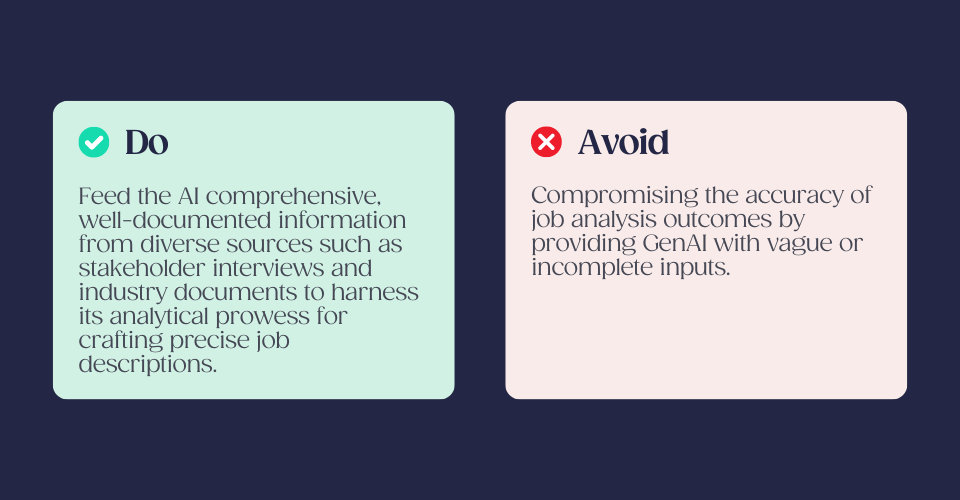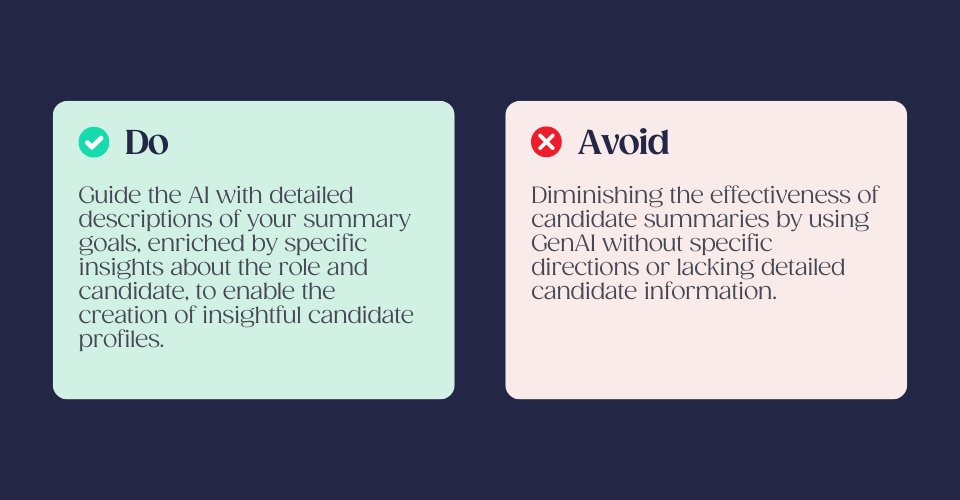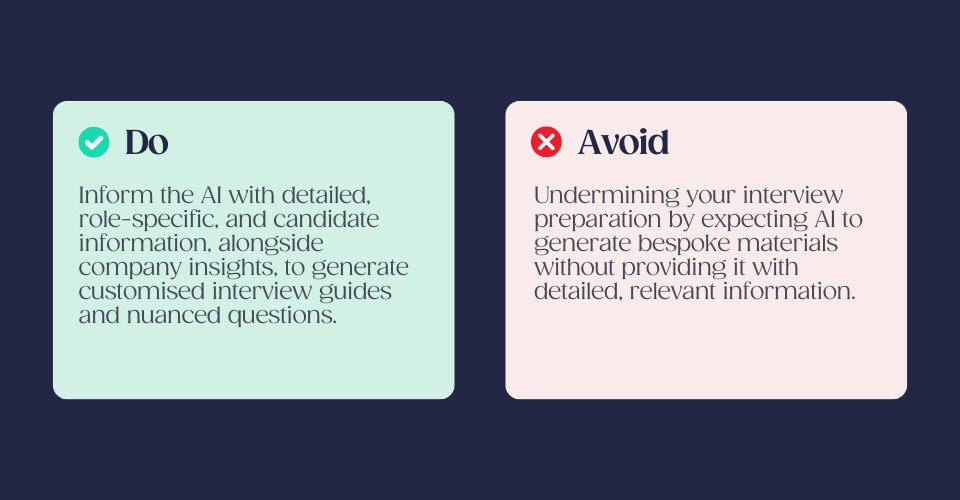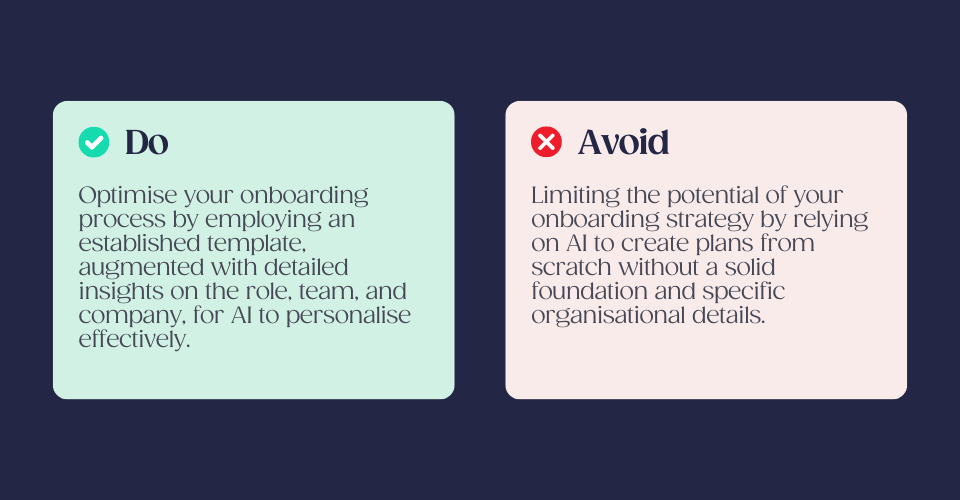The Ultimate Guide to Leveraging AI in Executive Hiring
Far from replacing human roles, AI boosts the precision, speed, and depth of executive searches. It empowers professionals to forge stronger, more insightful connections with candidates—ushering in a new era where technology amplifies personal expertise in executive hiring.
This practical guide draws on Generative AI (GenAI) applications to provide insights, highlighting the tangible benefits that AI introduces.
Learn how AI can help with:
- Job analysis
- Candidate summaries
- Interview prep
- Personalising onboarding
- Talent data analysis
Job analysis
Job analysis is a systematic process of identifying the skills, knowledge, and abilities required for a job. The core of job analysis is to gather specific information about the company and the role, and then analyse and synthesise said information. It’s the last part - analyse and synthesise, that Generative AI (GenAI) is best at doing.
The information that you provide needs to be clear and detailed enough for the AI to analyse.The effectiveness largely depends on the context and specific information about the company and the role that the user provides it.
This can come in many forms:
An article that talks about the position;
PDFs;
Word files;
Industry whitepapers;
Job descriptions;
Stakeholder interviews.
Once you’ve gathered all the relevant documents, notes, etc., you can feed all that into your GenAI tool of choice and use it to develop detailed job descriptions, hiring scorecards, job ads, and more.

Candidate summaries
Candidate summaries are an important, yet mundane and time-consuming part of hiring. A well-written summary can make a candidate stand out, while a poorly written one risks them being overlooked.
As with job analysis, GenAI tools offer incredible potential to streamline the task, but effectively utilising them requires more than a simple 'summarise' command.
You start by describing what it is you’re trying to achieve. Describe the format, what words to use, the tone of voice, what to concentrate on, etc. For clarity, you can include example summaries.
Next, you add background information about the role e.g. job analysis. This helps the AI understand what aspects of the candidate's profile are most relevant. And finally, you add the crucial candidate context or specific information about the candidate.
As with job analysis, the background information you provide needs to be clear and detailed enough for the AI to analyse. The more detailed the input is, the better the output is likely to be.
This can include:
- Candidate CV;
- LinkedIn profile PDF (direct LinkedIn access is blocked for most AI chatbots);
- Interview and/or call notes;
- Assessment results (personality, skills, etc)
- Data from reference checks
- Candidate cover letter

Navigating Interview Prep
Interviewing candidates is a critical skill, demanding not only a deep understanding of the role and company but also the ability to ask the right questions.
No AI has specific information about the company, the candidate, or the role you are hiring for. While it understands the general responsibilities of a CMO, specific roles and duties can vary greatly across companies.
Thankfully, this is easy to overcome by giving the AI the information it needs. This can take the form of various documents and files, along with notes, webpages, and more that contain specific information about the company, the role, and the candidate.
Information from all of the above sources will be analysed by the AI and used as foundational knowledge to build hyper-personalised interview guides, templates, and even complete scorecards with interview questions.
Areas where AI can help include (but are not limited to):
Role- and candidate-specific behavioural interview questions
AI can assist in creating hyper-personalised interview questions tailored specifically for the role, the company, and the candidate. It can also come up with follow-up questions and give pointers on how to recognise a strong answer.Feedback and evaluation templates
To ensure a structured and unbiased assessment process, AI can help you create an evaluation template with a scoring system either to be used already during the interview or right after to gather your thoughts.Interview logistics and structure
AI can suggest best practices for structuring the interview, including time management, the sequence of questions, and how to create a welcoming and respectful interview environment.

Personalising onboarding with AI
New employee onboarding is a key step in the hiring process that lays the foundation for a successful work relationship. It’s not about the first day(s) being a memorable experience but rather planning the first days, weeks, and months to quickly bring the new employee up to full productivity.
Most companies will have an existing onboarding plan that is tweaked whenever a new employee is hired. Analysing that plan can be the first step in using AI in an onboarding process.
You can ask the AI to craft a new onboarding plan from scratch, but for best results, you need an existing structure/template that you are happy. Without anything to go by, the AI will just make stuff up. It might end up amazing. Or the opposite.
As with other examples of using AI in the hiring context, the key lies in providing detailed background information about the role, the team, and the company for best results. This could include:
Interview notes
Job analysis results
A job description
CV and/or LinkedIn Profile PDF
Company overview
Team overview

Talent Data and AI
Beyond CVs, LinkedIn Profiles, interview notes, etc, you can use talent data from different psychometric assessments to provide valuable insights. However, they can be cumbersome to analyse in the context of the role and company.
To simplify this, we developed WisGPT, an AI chatbot with direct access to candidate-specific Wisnio talent data (based on our proprietary assessments of personality, values, and competencies) to deliver hyper-personalised insights.
With access to team and candidate-specific talent data and our proprietary training, WisGPT delivers hyper-personalised summaries and answers questions about the team, a particular team member or a candidate, allowing you to focus on the truly strategic aspects of hiring.
WisGPT adds an extra layer of insights that are hard, if not impossible, to get from CVs and LinkedIn Profiles. With it, you can better understand the candidate as a person and how they, as an individual, might fit into the existing team.
Conclusions
This guide has explored the potential of Generative AI (GenAI) to revolutionize executive hiring. By augmenting human expertise, AI empowers you to:
- Streamline routine tasks like job analysis and candidate summaries, freeing up time for strategic decision-making.
- Personalize the interview process with tailored questions, feedback templates, and even interview structures.
- Gain deeper insights into candidates through AI-powered talent data analysis, leading to informed hiring decisions.
Remember, AI is a tool, not a replacement. Its effectiveness relies heavily on clear communication and detailed input. By providing context-rich information about the company, role, and candidate, you unlock the full potential of AI and make smarter, data-driven hiring decisions.
Experience the benefits of AI without the hassle with WisGPT's user-friendly interface and seamless integration. It streamlines talent data analysis and provides hyper-personalised insights that go beyond traditional CVs and LinkedIn profiles.